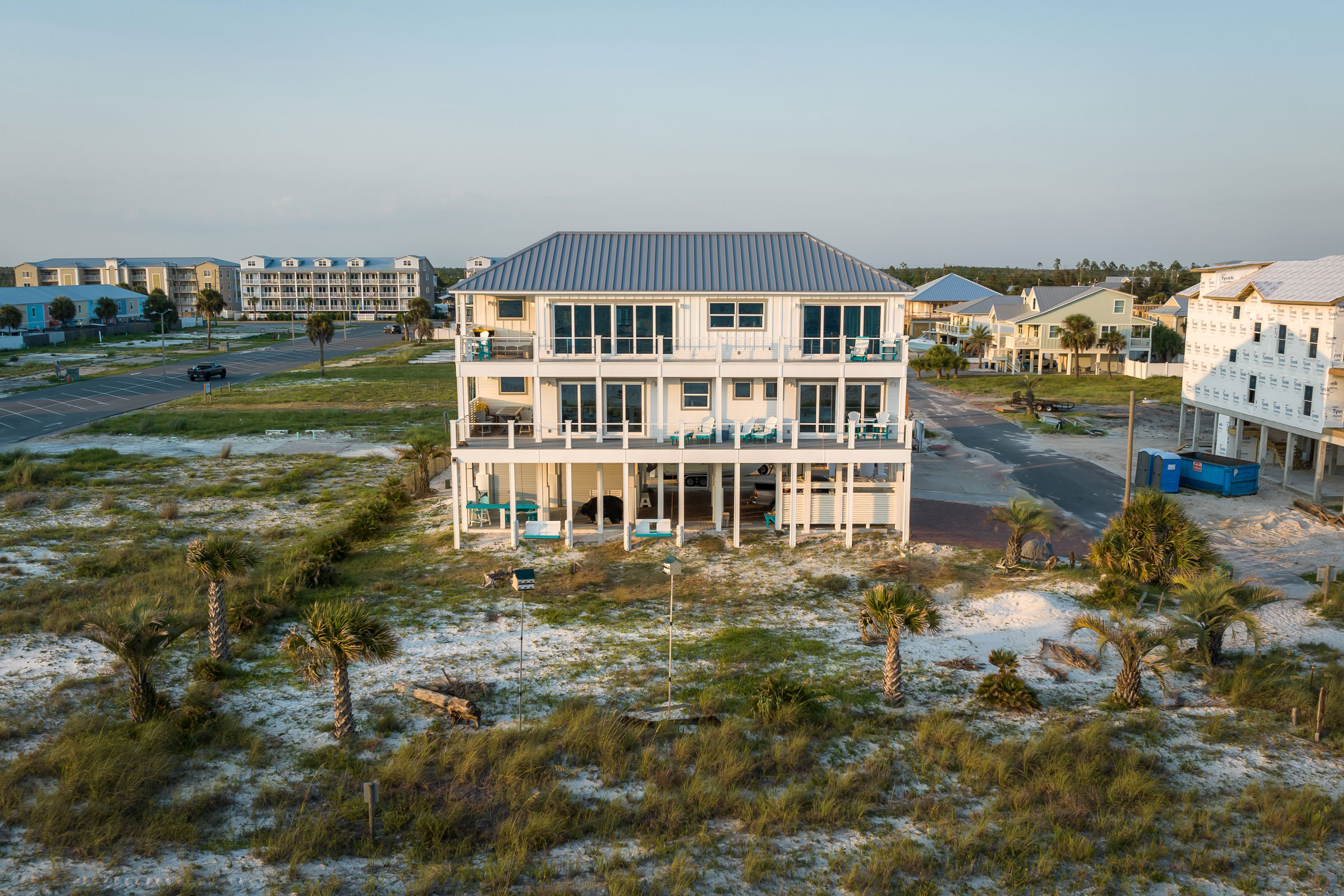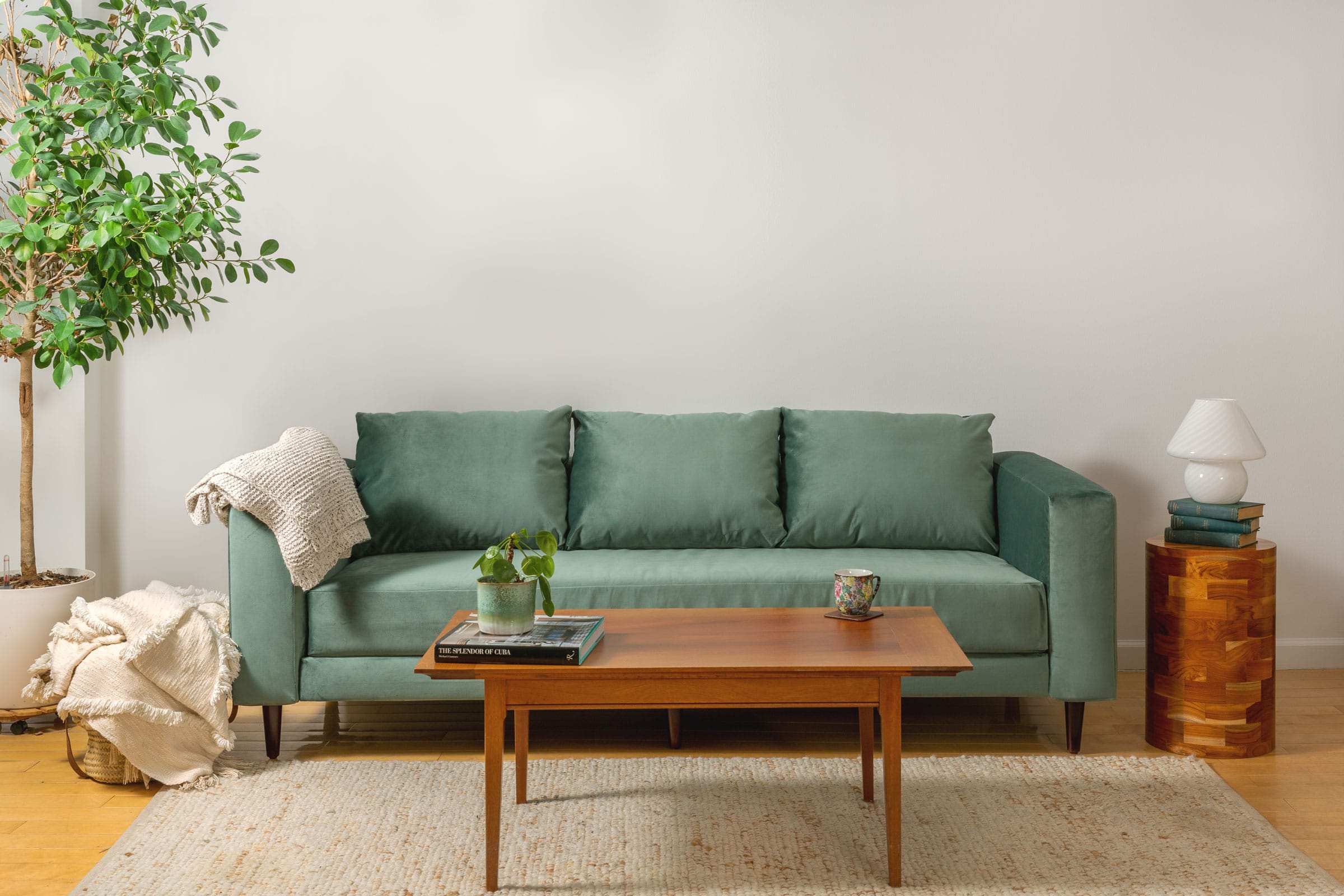Story at a glance:
- Designing with weather-resilient building materials is central to future-proofing the built environment.
- ICFs are amongst the most durable and wind-resistant weather-resilient building materials.
- Metal roofing offers a high degree of weather-resilience compared to other roofing materials.
As the effects of climate change worsen and extreme weather events increase in both frequency and severity, architects and other AEC professionals are placing a greater emphasis on designing with weather-resilient building materials.
This article is an introductory guide to designing with weather-resilient building materials.
The Effect of Extreme Weather on the Built Environment
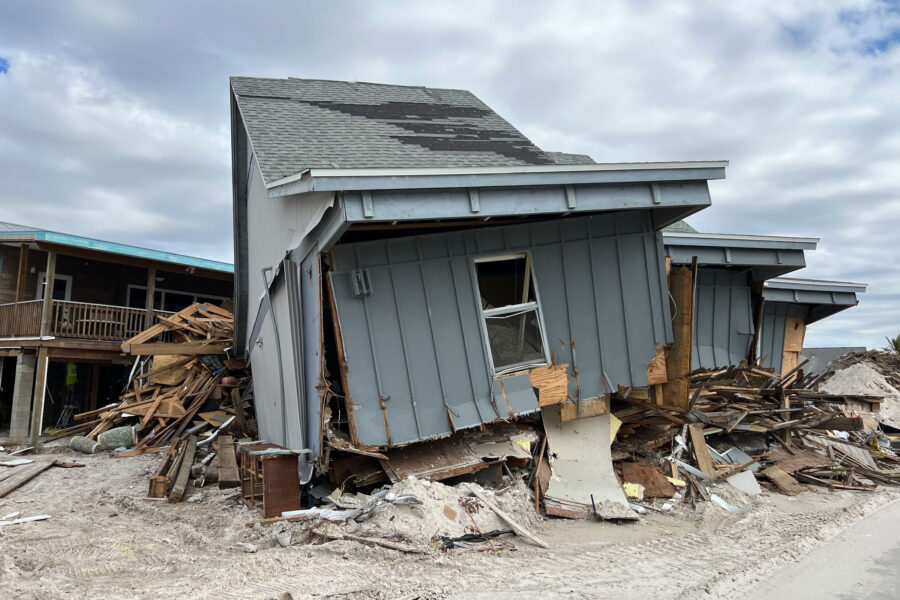
Extreme weather is on the rise and can pose a serious threat to the built environment. Photo courtesy of PGT Innovations
The construction sector and built environment at large are heavily impacted by extreme weather conditions.
Construction Setbacks & Delays
Extreme weather poses a threat to in-progress construction projects, potentially leading to costly setbacks and delays. Research suggests roughly 45% of all construction delays are caused by adverse weather conditions like heavy rain, wind, and snow. Delays like these ultimately cost billions annually in additional expenses and lost revenue.
Damages
Mild and extreme weather events can damage buildings in a number of ways, including:
- Impact damage to windows, doors, roofs, and siding from hail and windblown debris
- Water damage to foundations, basements, and ground floors from heavy rain events, floods, and storm surges
- Structural damage from windstorms, tornadoes, hurricanes, and derechos
Since 1980 the US alone has sustained more than 400 weather and climate-related disasters where overall damages met or exceeded $1 billion—and that’s to say nothing of the countless other weather events with damage totals in the hundred-millions.
Health & Safety Concerns
Property damage and economic losses aren’t the only concerns associated with extreme weather, as buildings are the main source of shelter during such events. Poorly designed buildings and the excessive usage of inappropriate building materials are two major contributors to injury and loss of life during weather-related disasters, making it all the more important to specify weather-resilient building materials.
Tips for Designing with Weather-Resilient Building Materials
Fortunately there are ways to minimize these risks and improve the built environment’s overall resilience in the face of advanced anthropogenic climate change and extreme weather events—like designing with weather-resilient building materials.
Insulated Concrete Forms
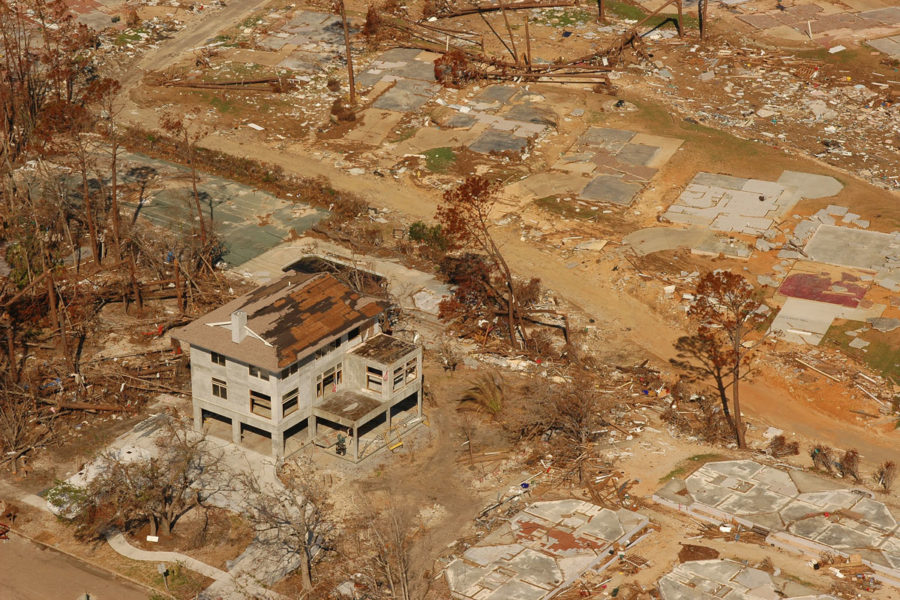
Built using ICFs, this house withstood Hurricane Katrina and was one of very few properties left standing after Hurricane Katrina hit Mississippi. Photo courtesy of ICFMA
Insulated concrete forms (ICFs) are a system of formwork for reinforced, cast-in-place concrete walls created by pumping concrete into hollow forms made from rigid foam insulation. Once the concrete sets the forms are left in place rather than removed, giving the wall improved insulating capabilities over traditional wood-framed walls while also providing backing for interior and exterior finish materials.
Like any concrete-based product, ICFs are extremely durable, inherently fire- and pest-resistant, and resist moisture accumulation. Further improvements can be made to waterproof ICFs—particularly those used for below-grade applications—making them suitable in places where flooding and storm surges are common occurrences.
ICFs are also incredibly resistant to lateral wind loads, making them an ideal choice for projects in areas where tropical storms and hurricanes are common. In fact, ICFs are commonly used to construct storm shelters thanks to their high impact resistance.
“At a minimum an ICF wall can withstand 150 mile per hour winds,” writes Brian Corder, CEO of BuildBlock ICFs and vice chair of the ICFMA, previously wrote for gb&d. “The steel reinforced concrete inside that wall provides structural stability, even from large debris. The foam on the outside delivers a large cushioning effect, too.” Most ICFs are designed to effectively weather 250 mile per hour winds, exceeding the 195 mile per hour standard of Miami-Dade certification.
Fluid-Applied Flashing
Flooding in both rural and urban areas has become a growing concern as tropical storms, hurricanes, and extreme rain events increase in both frequency and severity. To help prevent—or at the very least, minimize the extent of—water damage to building interiors and structural components, it is extremely important that all gaps, cracks, and openings in the building envelope be properly sealed with the appropriate flashing.
Aluminum, copper, and galvanized steel are amongst the more conventional flashing materials, but fluid-applied flashing is typically considered to be a much more efficient and high-performance alternative. Usually made from a silyl terminated polyether—or a combination of silicon and urethanes—fluid-applied flashing is a caulk-like material that can be used to create continuous, unbroken air- and water-tight barriers around seams, window openings, doors, et cetera.
Because it is a liquid, fluid-applied flashing is extremely versatile and is ideal for sealing challenging and oddly shaped areas where traditional flashing materials may not work or where they would create a reverse-lap—that is, an area where flashing located higher up on a structure terminates behind flashing located lower on the structure, creating a gap where air and moisture may enter. The inherent elasticity of fluid-applied flashing also allows it to move with a structure during periods of high wind and seismic disturbances, making it less likely to fail when needed most.
Structural Insulated Panels
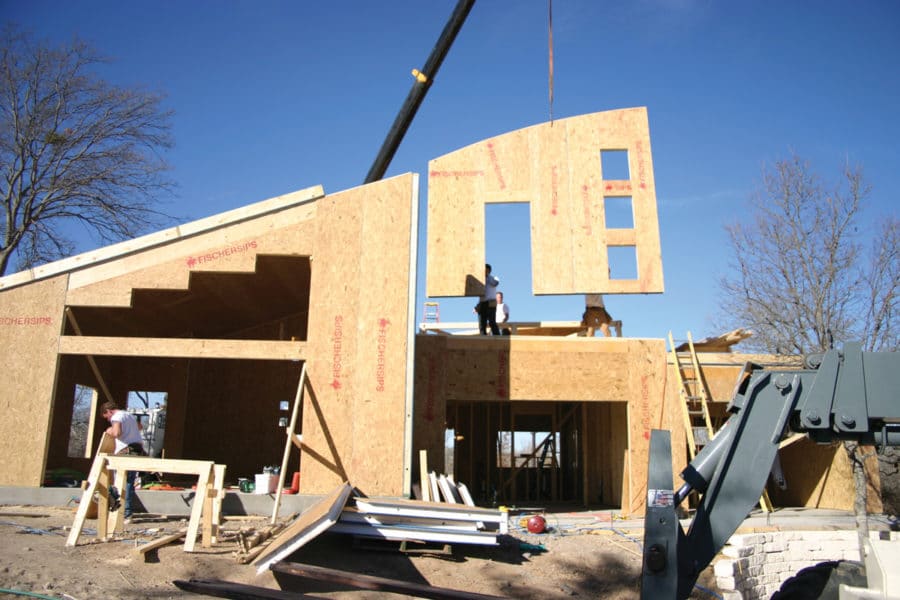
Photo courtesy of FischerSIPS
Structural insulated panels (SIPs) are a type of lightweight, high-performance composite paneling used in residential and light construction projects to create walls, floors, roofs, and even foundation systems. SIPs are designed to share the same structural properties as traditional I-beams or I-columns, with the insulated core acting as the web and the sheathing fulfilling the function of the flanges.
On average buildings constructed from SIPs are two-and-a-half times stronger than conventional stick-framed structures. This structural strength, combined with their general construction, also means SIPs are incredibly resilient and well-equipped to withstand extreme weather events. “The way SIPs are tied together with the long panel screws creates incredible sheer strength,” Damien Pataluna, owner of FischerSIP, previously told gb&d. “You won’t typically have situations where the trusses or individual pieces of sheeting can be ripped off the roof because the roof panels are one solid sheet inside and outside that are screwed down to the walls. You’d almost have to pick up the entire house to rip it off the foundation.”
Most SIPs are capable of withstanding 145 mile-per-hour winds without necessitating any additional tie downs, allowing them to weather tropical storms, category four hurricanes, and EF2 tornadoes without suffering debilitating damage. SIPs are also designed to resist water intrusion and maintain their structural integrity when exposed to moisture, making them ideal in flood-prone regions.
Terra-Cotta Tiles
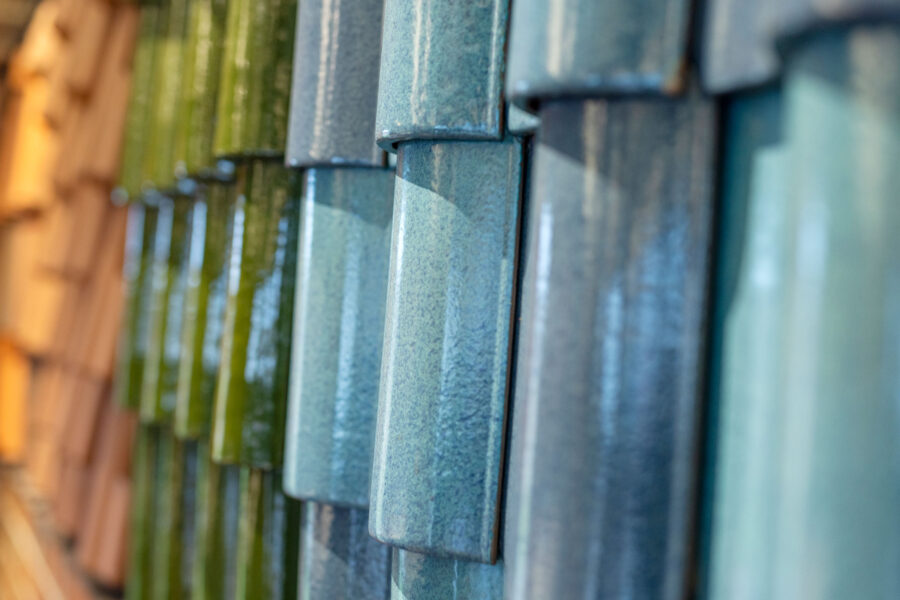
Photo courtesy of Ludowici
While not the most obvious weather-resistant building material, terra-cotta tiles nevertheless possess an admirable capacity to withstand harsh conditions and climatic events without suffering significant damage. This is largely due to the firing process terra-cotta tiles are subjected to during manufacturing, as high heat causes the clay particles to fuse together and form a strong, solid mass.
Terra-cotta tiles also have a high wind uplift capacity and are capable of achieving an impact rating of Class 3 or Class 4, meaning they are more than capable of protecting against wind, storm debris, and hail. Some terra-cotta manufacturers—like Ludowici—go above and beyond to ensure that their tiles will stand the test of time, regardless of the conditions they’re exposed to.
“Our tiles have the highest wind uplift capacity and weather performance of any clay tile on the market. The high-quality composition of our tiles results in very high breaking strengths, allowing them to resist wind stress during extreme weather events, such as tornadoes and hurricanes,” Rob Wehr, vice president of business development and national accounts at Ludowici, previously told gb&d. “When properly installed high-quality terra-cotta tiles can sustain winds in excess of 125 miles per hour—the kind that would easily strip off many other roofing materials.”
Ludowici’s terra-cotta tiles are also extremely dense and therefore have a very low capacity to absorb moisture, reducing their risk of cracking during freeze/thaw cycles. “We make our clay body dense enough that it doesn’t soak up water in the first place,” David Jensen, sample coordinator, glaze production scheduler, and color consultant at Ludowici, previously told gb&dPRO. “That’s something we take pride in because even though it may not be the most glamorous aspect of the tile, the clay body is really what lets our product last as long as it does in so many different environments.”
High-Impact Glass
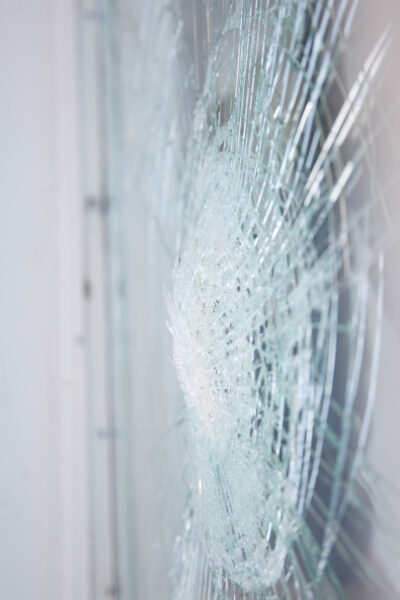
Photo courtesy of PGT Innovations
Windows, window walls, and other glass-covered openings in a building are crucial for daylighting and comfort purposes—but they also represent major weak points in a building’s envelope when it comes to wind-related disasters like hurricanes, tornadoes, and derechos.
“When a hurricane hits a house, there are positive and negative air pressures pushing and pulling on every ‘opening’ of your home—windows, doors, and garage doors,” Mike Wothe, vice president of operations at PGT Innovations, told gb&d in a previous interview. “If the glass in a window or door breaks, or if an opening is somehow otherwise breached, winds can rush into a home, pressurize the inside, and literally lift the roof off and blow the walls out. So in addition to flying debris damaging a home during a storm, pressurization of the home can blow it apart.”
Installing high-impact glass can help to greatly reduce these risks and better safeguard occupants during periods of extreme wind speeds. True impact glass is designed and tested to withstand hurricane-force winds of 110 miles per hour (at a minimum), as well as dramatic pressure shifts and high velocity impacts from flying debris.
PGT Innovations—in collaboration with Corning Incorporated—has been working to improve impact glass technology even further by making glass units thinner and lighter while still retaining top-tier impact resistance. PGT Innovations’ Diamond Glass, for example, is up to 45% lighter and three times more scratch-resistant than traditional laminated glass but still meets rigorous Miami-Dade testing standards.
Metal Roofing
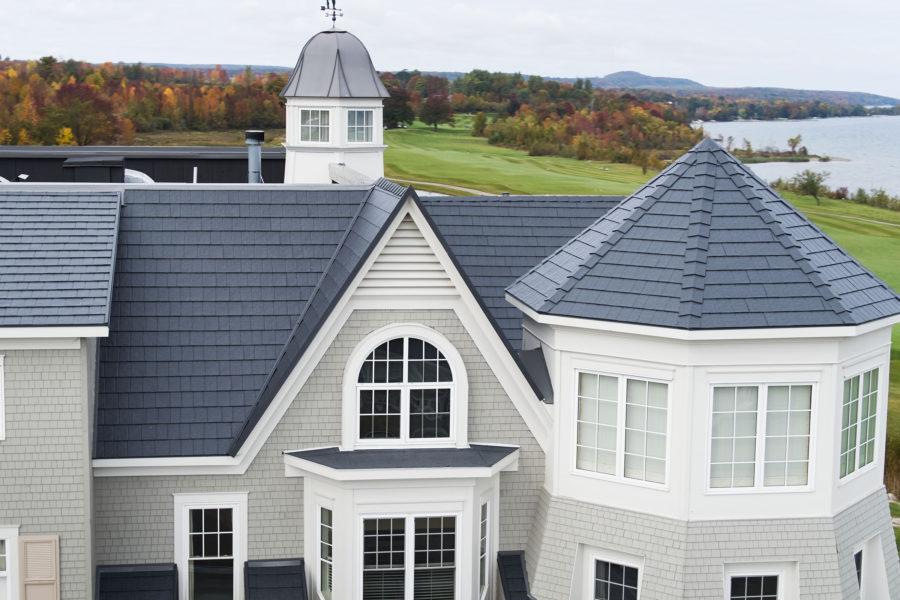
Photo courtesy of Vicwest
Of all a building’s components, few are as susceptible to weather-related damage as the roof. And while it’s true that exterior-facing features like roofs are designed to be the first line of defense against the elements, not all roofing materials offer the same level of protection against adverse weather.
Out of all the options out there, metal roofing—typically made from copper, aluminum, or steel—is amongst the best when it comes to universal weather resilience, as it is capable of withstanding heavy rain and snow, strong winds, fire, and even hail without failing. Vicwest’s True Nature metal shingles, for example, are engineered to withstand everything Mother Nature throws at it.
“We have put True Nature through the most rigorous testing available, and it has proven to perform against extreme conditions like wind uplift, wind-driven rain, hail damage, fire, and corrosion,” Geoff Bernstein, director of marketing at Vicwest, told gb&d in a previous interview. “Plus we are certified for use in Miami-Dade County—the gold standard in this industry for protection against heavy rains, winds, and saltwater. So no matter what part of the country you live in, our products are a great solution for whatever weather you may face.”
Because True Nature is made from Galvalume steel featuring an anti-corrosive metallic coating with self–healing properties, the tiles are also protected from rusting/saltwater corrosion and are extremely impact-resistant, meaning they will continue to perform well for the long-term even in areas prone to severe weather.
Fiber Cement Siding

The exterior walls are mostly made of colored fiber cement by Cement Board Manufacturers. The roof is by Drexel Metals and features wood accents along with eaves. At night sconces on either side of the front door light up for wayfinding. Photo by Nat Rea
Similar to roofing, a building’s siding or cladding is designed to shield occupants and structural components from the elements, making it particularly vulnerable to weather-related damage. Many siding products offer an admirable degree of protection against certain environmental factors, but few provide the same level of all-around protection as fiber cement siding.
Made from a combination of cement, sand, and cellulose fibers, fiber cement is an incredibly durable and long-lasting material with unparalleled weather-resistance capabilities. Siding made from fiber cement is inherently fire- and pest-resistant (unlike most wood siding), can weather temperature fluctuations and extreme cold without warping or cracking—a common issues with vinyl siding—and boasts a high degree of moisture-resistance, making it ideal in humid and flood-prone regions.
Fiber cement siding is available in a range of thicknesses, with thicker versions offering greater protection against wind-blown debris, hail, and other high-velocity impacts.

